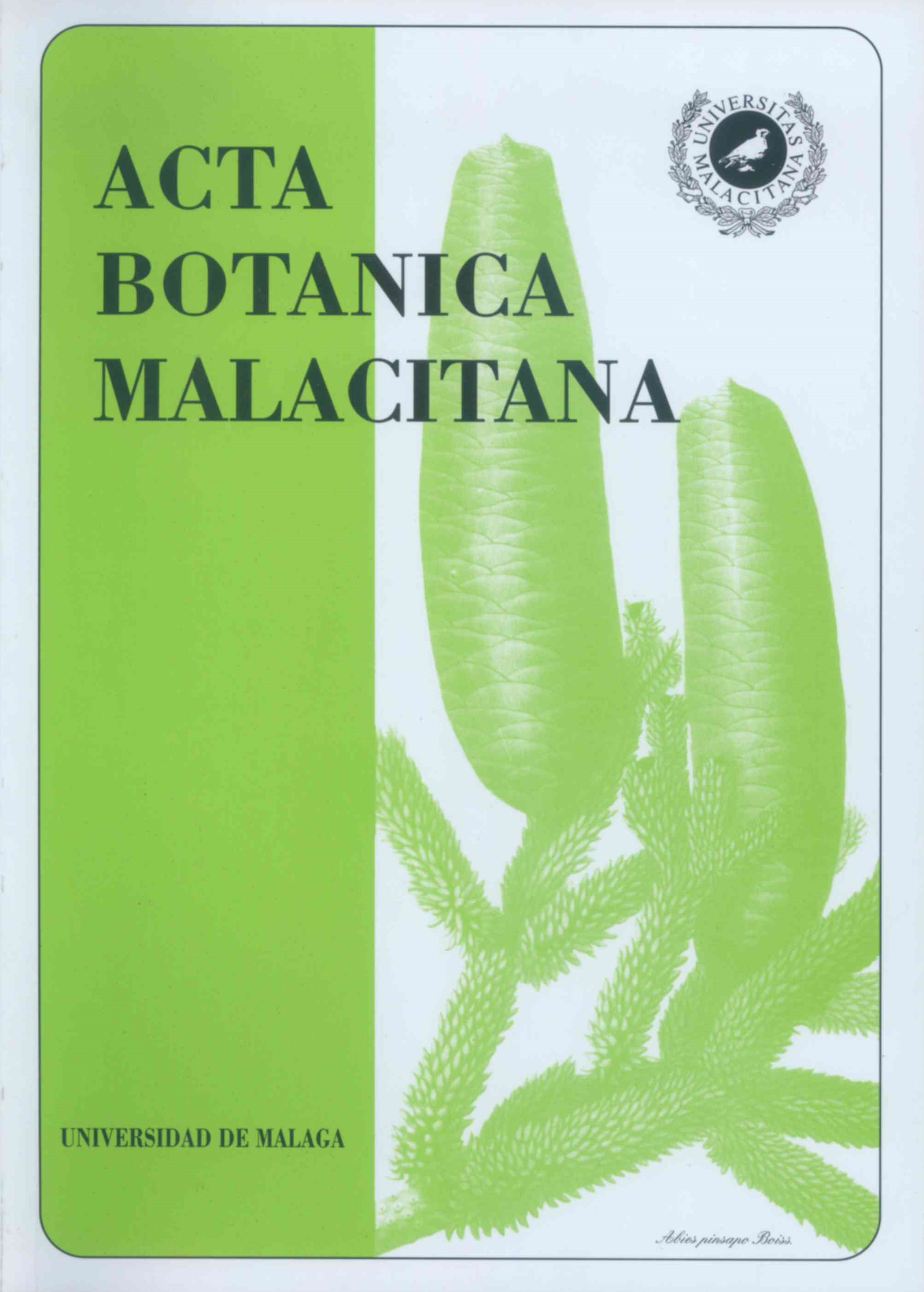The epiphytic lichenic communities of the Sierra del Caurel (Lugo, Spain)
DOI:
https://doi.org/10.24310/abm.v27i0.7304Keywords:
Vegetation, lichens, epiphytic, Sierra do Caurel, LugoAbstract
The epiphytic lichenic communities of the Sierra del Caurel (Lugo, Spain) has been studied. The following syntaxa are mentioned: Hypocenomycetum scalaris Hil. 1925, Lecanoretum subfuscae Ochsner 1928, Pertusarietum hentisphaericae Almb. 1948 ex Klem. 1955, Pseudevernietum furfuraceae Almb. 1948, Parnzelietum caperato-perlatae Delzenne & Géhu 1977, Physcietum ascendentis Ochsner 1928 y Nephrometum laevigatae Barkm. 1958.
Downloads
Metrics
References
AMIGO, J. -1985—Estudio de/os matorrales y bosques de la Sierra del Caurel (Lugo). Tesis Doctoral. Universidad de Santiago de Compostela. Inédita.
BAHILLO, L. -1989- Vegetación y flora de los líquenes eítfitos de la cuenca del río Oitavén (Pontevedra). Tesis doctoral. Universidad de
Santiago de Compostela. Inédita.
BAHILLO L. & R. CARBALLAL -1992- La alianza Usneion barbatae Ochsner 1928 en la cuenca del río Oitavén (Pontevedra, NO de España). Nova Acta Cientifica Compostelana (Bioloxía), 3 : 37-48.
BARKMAN J. J. -1958- Phytosociology and ecology of cryptogamic epiphytes. Van Gorcum & Comp. N. V. Assen: Van Gorum & Comp. N. V., 646 pp.
BRAUN-BLANQUET J., -1951/1979- Fitosociologia, bases para el estudio de las comunidades vegetales. Madrid: H. Blume, 820 p.
BURGAZ A. R. & E. FUERTES -1992- Aportaciones a la vegetación epífita (Briófitos y líquenes) II (La Rioja, España) . Cryptogamie, Bryol.
Lichénol. 13(2): 133-153.
CARBALLEIRA A., C. DEVESA, R. RETUERTO, E. SANTILLANA & F. UC1EDA -1983- Bioclimatología de Galicia. Fundación Pedro Barrie de la Maza, Conde de Fenosa, La Coruña. 391 p.
CLAUZADE G. & Cl. ROUX -1985- Likenoj de Okcidenta Enropo, Ilustrita determinlibro. Royan: Societé Botanique du Centre-Ouest, 893 pp.
CRESPO A., E. BARRENO & L. GARCÍASANCHO -1983- Esbozo de la vegetación liquénica de algunas localidades de los valles del Tambre y Ulla (La Coruña, España). Trab. Compostelanos Biol., 10: 87-108.
DELZENNE Ch. & J. M. GÉHU -1979- Sur deux associations epiphytes du Parmelion caperatac des plaines et collies franÇaises. Doc. phytosoc., II: 117-126.
EGAN R. J. -1987- A fifth checklist of the lichenforming, lichenicolous and allied fungi of the continental United States and Canada. The Bryologist 90(2): 77-173.
EGAN R. J. -1990- Changes to the ofifth checklist of the lichen-forming, lichenicolous and allied fungi of the continental United States and
Canada». Ed. II, The Bryologist 93(2): 211-219.
ETAYO J. -1990- Ensayo de la vegetación liquenica epífita del norte de Navarra. Principe de Viana, 10: 39-71.
IZCO J., AMIGO J. & GUITIAN J. -1985- Botánica. In: Guitian Ojea et al., Estudio del medio natural de las montañas gallegas. I. El Caurcl. Institutuo de Estudios y desarrollo de Galicia. Universidad de Santiago.
JAMES P. W., HAWKSWORTH D. L. & ROSE F. -1977- Lichen communities in the British isles: A preliminary conspectus. In: Lichen Ecology. Seaward, M. R. D. (ed.). London: Academic Press. Pp 295-413.
MARCOS B. -1986- Flora y vegetación liquénica epífita de las Sierras meridionales salmantinas. Salamanca: Ediciones Universidad de Salamanca. Series de resúmenes de tesis doctorales.
RITSCHEL G. A. -1977- Verbreitung und Sociologic epiphytischer Flechten in Nordwestbayern . Biblioth. Lichenol., 7: 192 pp.
ROSE F. -1988- Phytogeographical and ecological aspects of Lobarion communities in Europe. In: Dalby, D. H.; Hawksworth, D. L. & Jury, S. L. (ed.) «Horizons of Lichenology» . London. Academic Press.
Downloads
Published
How to Cite
Issue
Section
License
Copyright (c) 2019 Acta Botanica Malacitana

This work is licensed under a Creative Commons Attribution-NonCommercial-ShareAlike 4.0 International License.
All information related to the licensing of published works in Acta Botanica Malacitana and copyright can be found in our Editorial Policy.







1.png)
